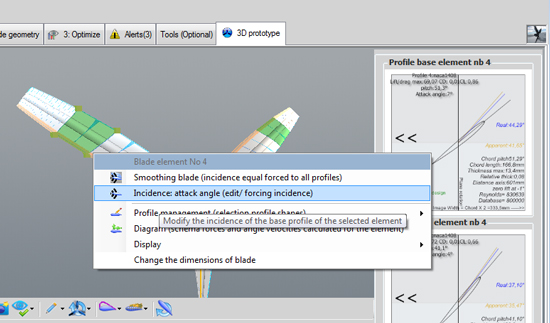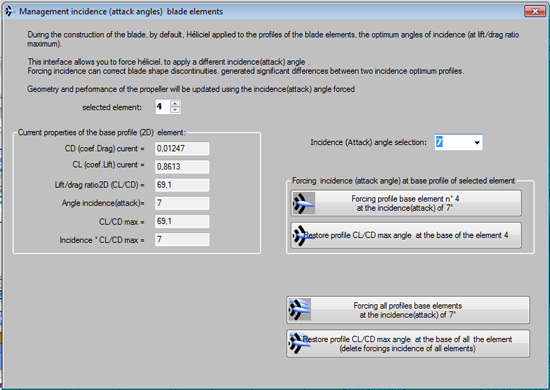design propeller blades angles for turbine, screw, aerial, marine, turbine, tidal, wind, kaplan, foil, wings with heliciel software:
discover heliciel software and Mecaflux suite softwares
blade or wing profiles incidence attack angle management
Understand and master blade or wing profiles attack angle using propellers design software Heliciel:
Whatever the law of selection profiles HELICIEL apply default, the incidence(attack angle) of selected profile providing the lift / drag ratio maximum. Twist of the blade will be built taking into account the induced velocities and incidence lift / drag ratio maximum.
In some cases, it may be useful to consider the incidence(attack angle) that we want to give to an element of the blade or wing. HELICIEL leaves the possibility for the user, to select the incidence, he wants to apply to the profiles base of the elements.

- L= Lift force perpendicular to the movement of the fluid in Newtons
- D=Drag force parallel to the movement of the fluid in Newtons
- alpha=Angle of incidence
- For wind turbines, it is often useful to apply angles of incidence "maximum lift" in the area of the blade root to allow a better start of the machine. Profiles involved, being near the center of rotation ,loss of lift / drag ratio deteriorated slightly, the overall performance of the propeller of which the most effective area is 0.7 times the radius.
- For highly loaded propellers, which should generate a strong thrust with limited diameter. When the work surface has been maximized, and that the rotational speed is imposed by the engine performance, it is possible to increase thrust by increasing the angle of incidence, mais ceci degradera le rendement...
- If the propeller cavite, it may be useful to decrease slightly lift, reducing the incidence, but the thrust will be reduced ...
To access the incidence (attack angle)management, left click on the element in the 3D model, et sélectionner dans le menu contextuel:"forcage de l'incidence":


Héliciel calculates speeds induced following the performance to the selected incidence and adjusts the pitch of the profile relative to the direction of fluid velocities induced corrected.Here for example, this three-bladed propeller turbine, has the profile of basis for its element 3 who was forced to an incidence of 48 degrees from the direction of the fluid..


 Global site map
Global site map Mecaflux
Mecaflux Tutorials Mecaflux Pro3D
Tutorials Mecaflux Pro3D Tutorials Heliciel
Tutorials Heliciel Mecaflux Store
Mecaflux Store Compare software functions
Compare software functions Quotes, Orders, Payment Methods
Quotes, Orders, Payment Methods project technical studies
project technical studies